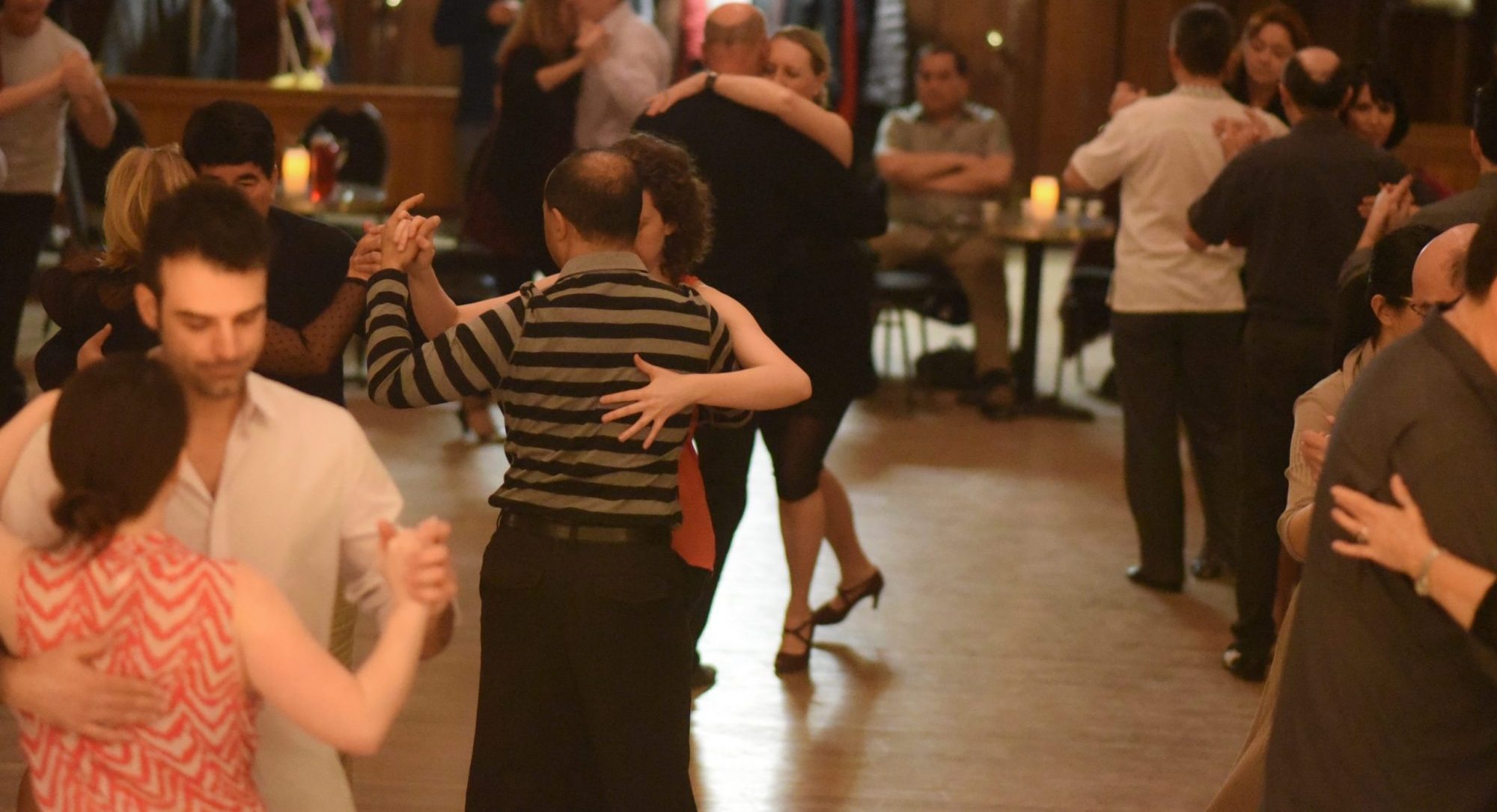The word milonga has three meanings:
- it’s a tango dance party
- it’s a subset of tango music
- it’s the dance danced to that subset of tango music
When we talk about “milonga etiquette,” we’re talking about the interactions that happen at a tango dance party.
1. How do milongas work?
- Music is played in sets of 3 to 4 songs. These groupings are called tandas.
- There are 3 types of music played at a milonga:
- Tango is the “regular” music you’ll hear most of the time.
- Vals (sometimes called vals tango or vals cruzado) has a 3/4 waltz rhythm but with tango instruments.
- Milonga is faster, more rhythmic music.
- Between each tanda is a cortina, a snippet of non-tango music that tells everyone that the tanda is over. This is the time to sit down or invite someone else for the next tanda.
- It’s fine to ask someone to dance after the tanda has started. You could ask someone to dance after the first two songs go by.
- It’s expected that you will at least dance the tanda to the end with your partner. Stopping in the middle of a tanda (“breaking the tanda”) generally means that something has gone very wrong.
- Some people elect to dance multiple tandas with a partner, but this means different things in different places.
- Dancers usually use cabeceo ask each other to dance, but this isn’t always the case (see #3).
2. What exactly is cabeceo?
It is the way to invite someone to dance. The request is done by making sustained eye contact with the dancer of your choice. The dancer accepts the invitation by slightly nodding. If he or she refuses the invitation for any reason, eye contact will be broken by their looking away.
Notice that we are using gender-neutral language. Leaders of any gender can initiate cabeceo. Traditionally it’s men who cabeceo, as most leaders are men. But women still need actively look around, and they have the power of “no.”
It is important to use a kind of cabeceo between leaders to come onto the dance floor when the tanda has started. It’s the same as drivers using their signals and looking first before turning onto a main street. Followers can help with this process as well by not jumping into the line of dance without looking.
3. Is the cabeceo used in Ottawa?
Cabeceo is not used all the time in Ottawa. Our community is small enough that many people know each other and verbally ask each other to dance. However, experienced dancers who are familiar with cabeceo often use it, even with friends. It’s a handy skill to have, especially when you visit other communities to dance.
4. Do I have to dance with everyone who asks me? Or, do I have to make sure to ask everyone to dance?
Anyone can politely refuse a dance for any reason; you’re tired, or want to chat or watch the other dancers. You do not need to explain yourself to anyone, but please be gracious.
You should only dance when or if you really want to. If you have the energy to dance a tanda or two with someone newer to tango or just newer to you, this is highly appreciated by the community.
5. What are some big no-no’s at the milonga?
- Teaching or otherwise criticizing your partner at a milonga is heavily frowned upon, whether it’s during a tanda or off the dance floor. Many dancers will decline to dance with you again if you attempt to teach them during a milonga.
- Ignoring floor craft is poor practice. Argentine Tango is danced counterclockwise around the dance floor, and often couples form lanes so that the dance floor keeps flowing. Switching lanes constantly, “tailgating,” holding up traffic, and stepping backwards against the line of dance are all unsafe for your partner and the other couples around you.
6. How do you dress for milongas?
Many people choose to dress nicely for milongas and make an evening of it. You’ll also see people in jeans and casual clothing at local milongas. At gala-type events you’ll see suit coats (sometimes ties but not really these days) and gorgeous tango dresses, but in reality you just need to dress a bit better than you would for a “regular” milonga.
You should be able to move freely and feel comfortable in your outfit. There’s nothing less elegant than being restricted by your clothes!
Wear shoes that you have worn before for tango – that way you know they are comfortable and functional. At some point, you might want to match your shoes to your clothes or get “real” tango gear, but for a local milonga it’s not essential.
The important thing is personal hygiene. Argentine Tango is danced closely, so body odor and bad breath are to be avoided. Siempre Tango advocates a scent-free environment as well because excessive perfumes and colognes can cause allergic reactions.

